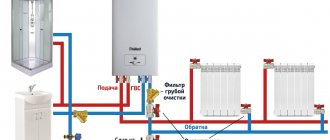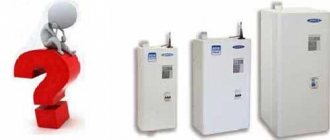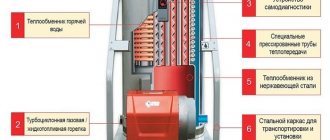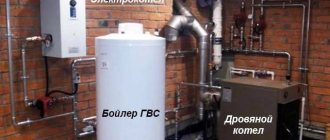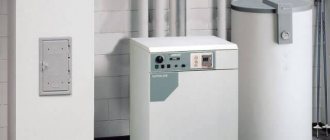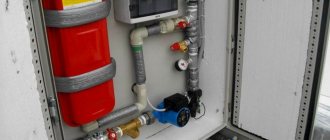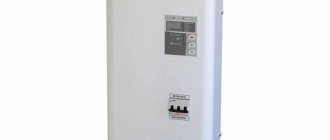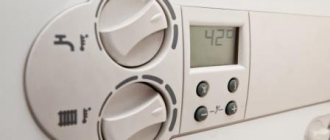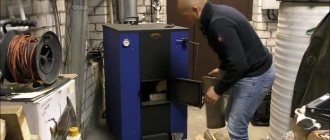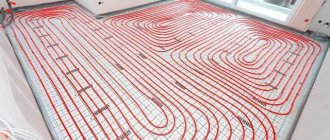Advantages and disadvantages
Choosing an electric boiler is a responsible matter, as is the arrangement of the heating system in the house itself, so it is important to clearly understand the pros and cons of such equipment. So, the undeniable advantages of the unit include:
- Reliability and safety: the operation of such a system is not associated with open flame or combustion. The equipment is as safe as possible if it has high-quality wiring and all the necessary fuses.
- No emissions: this is both environmentally friendly and safe, because there is no risk of suffering from carbon monoxide indoors.
- Compactness: the unit can fit in almost any room, it does not need a separate boiler room, and there are no foreign odors from it. Such boilers fit perfectly into the interior of a hallway or kitchen.
- Installation of an electric boiler is quite simple and does not require major interventions in the structure of the house (no need to remove chimneys, etc.), as well as the provision of utility rooms for fuel storage.
- Ease of operation: there is no need to add fuel or clean the equipment, everything is controlled on a convenient panel.
- The affordable cost comes from a fairly simple design, because many gas and solid fuel boilers today are much more complex in their structure, and therefore cost an order of magnitude higher.
In fairness, it is worth mentioning the existing shortcomings of such systems.
- The cost of electricity is the most significant disadvantage of the equipment. Before purchasing, be sure to calculate future monthly energy costs when heating your home with it.
- Dependence on power supply – such a system, and, consequently, the comfort in your home becomes completely dependent on electricity. If there are power surges or power outages, you should think seriously before purchasing such a boiler. It is possible to purchase a combined model – “electricity/solid fuel”.
Features of using an electric boiler in a private home
All electric boilers are designed to heat coolant, which, with the help of pumping equipment (sometimes naturally), circulates through pipes, giving off heat to radiators or convectors. This is classic water heating with its characteristic wiring methods, with its pros and cons. The system may include a water floor circuit or an indirect heating boiler for domestic hot water.
One of the electric boiler connection diagrams
Disadvantages of electric boilers:
- High cost of each kilowatt of heat.
- The system is demanding on the quality of the network power supply; in case of interruptions, the heating is turned off.
- The allocated capacities are not enough; special permission from the supplier company is often required.
- To connect powerful units, it is necessary to provide three-phase power supply with a voltage of 380 V.
- Thorough water purification is required.
The main advantages include:
- Reliability of the system and simplicity of installation of electric boilers. Even for an unprepared person, choosing a heating boiler for a home is not a problem.
- Low capital costs for equipment, inexpensive and simple installation.
- The heating does not require special care during operation; the system can be easily automated.
- Safety of electric boilers (no fire, no combustion products, room oxygen is not consumed).
- The equipment is compact, no separate furnace is needed, no ventilation is required, and there are no restrictions on its location.
All the working elements of this wall-mounted boiler are located inside the housing with a modern design
Criterias of choice
Modern industry takes into account the reasonable demands of customers who are looking for reliable and high-quality equipment for their homes. All clients have different criteria, and therefore, for their convenience, many options for heating equipment have been created today. In order not to get lost in the assortment and know which electric boiler to choose, it is important to consider a number of criteria.
- Type according to the type of heater: it can be an electric boiler with heating elements, induction models or an ion (electrode) heating boiler.
- Purpose: single-circuit models for heating a room or single-circuit models with a built-in boiler for hot water in the house.
- Power - when calculating power by footage, the figure is 1 kW per 10 m2, however, such figures are extremely approximate, because it is also worth taking into account the quality and type of heating of the house, the number of windows, doors, balconies, the presence of a basement and attic, glazing area, connection diagram batteries and much more.
- Additional functions - you can choose an extremely simple model, or you can supplement it with various protection systems (from overheating, short circuits, excessive pressure, etc.), a GSM controller that allows you to remotely control the system, smooth power control, etc.
- Dimensions and method of placement of equipment - think in advance about the possible location of the unit. Imagine how harmoniously the future boiler will fit into the interior or whether it will require a separate room. Remember that installing heating equipment is not like installing a sofa that can be moved in a week.
What parameters should you pay attention to when selecting a boiler?
A household heating boiler is a complex technical device that contains not only a heating element. When purchasing, you need to pay attention to auxiliary components and additional options on which the reliability of the entire unit, safety and ease of use depend.
Expansion tank
An expansion tank for closed heating systems is a small container with an internal membrane dividing it into two halves filled with water and air. It allows you to compensate for the thermal expansion of the liquid during temperature changes. Without it, a sharp increase in pressure is possible with the danger of pipe rupture. If it is not included in the boiler kit, you will have to buy it in addition.
Expansion tank for heating system.
Possibility of working with a multi-tariff meter
When installing a multi-tariff meter, it becomes possible to pay more economically for the energy consumed. The heating system has a certain inertia. If it is heated intensively at night, when minimum tariffs apply, during the day it will be able to gradually release heat. Regulation of the boiler operation according to a schedule in automatic mode is carried out in the presence of a programmer.
Pump
A circulation pump is necessary to pump coolant throughout the entire circuit. It provides optimal conditions for the heat exchange processes occurring in the boiler and external heating devices. It is economically feasible for it to be able to change the flow rate of the pumped liquid. If this is not provided by the boiler manufacturer, it is better to purchase an additional regulator.
Weather-compensated regulation
Most well-known manufacturers of electric boilers provide the ability to operate the equipment depending on the readings of temperature sensors, which can be installed in a heated room or outdoors. This function improves the quality of maintaining a comfortable microclimate in the house and makes it possible to significantly save energy consumption.
Diagram of a heating system with weather-compensated control.
Three way valve control
When operating a single-circuit boiler, an additional indirect heating boiler is installed to provide hot water supply to the building. To do this, the manufacturer must provide the ability of the control system to give commands to the three-way valve, which is responsible for the timely supply of hot water to the storage tank. Without this option, high-quality operation of the DHW system will be impossible.
Possibility of connection to load shedding relay
When several powerful electricity consumers operate simultaneously, the home network may experience overload. This threatens to trigger emergency protection and cut off power to the building.
The priority consumer selection function implemented on the boiler allows you to automatically turn off the boiler when an alternative device that is more important from the point of view of the given logic is turned on. The unit will return to its previous mode as soon as such an opportunity arises.
Boiler types
A little higher, we have already said that electric boilers can be:
- with heating elements (tubular heaters);
- induction;
- ionic (electrode).
Boilers with tubular heaters are similar in structure to many household appliances - kettle, iron, boiler. The models are very popular and varied: there can be 1 or several heating elements, and they can be turned on simultaneously or in turn. The advantages of such designs include simplicity, as well as ease of repair and reliability. Among the disadvantages are the slow heating of boilers, high demands on the quality of the coolant (scaling is possible, and therefore special water preparation or a special coolant is desirable).
Induction models are valued for their reliability, energy efficiency and long service life. The devices are not afraid of scale, heat up quickly, and also offer precise adjustments. Among the disadvantages of the models are the large mass of the devices, vibration noise during operation, considerable cost, as well as the need for separate installation of a circulation pump, expansion tank and safety group.
Ion boilers heat the coolant by applying voltage through electrodes. Devices can be located either in a housing or without it. Both a small design for heating one radiator and a serious installation for heating a large house are possible. Such devices quickly heat up the coolant, allow precise adjustment, are not afraid of voltage surges, and are pleasing with their low cost and high safety. The disadvantages include complete incompatibility with steel and cast iron batteries, high demands on the circulating fluid (it is recommended to purchase ready-made ones separately), special requirements for the grounding circuit, heating temperatures up to 75°C, as well as the need for subsequent replacement of the electrodes.
On a note! A single-phase network (at a voltage of 220 V) can power equipment consuming up to 12 kW/h. More powerful devices require a three-phase network (380V).
Types of electric boilers according to operating principle
- Rheostatic devices (indirect action) have a heat exchanger tank, inside of which heating elements are installed - heating elements. These boilers are somewhat larger than electrode models, but they are less sensitive to the quality of the coolant.
Note! Scale on heating elements significantly worsens the level of heat transfer of the heating element, which causes the coil inside to overheat greatly and reduce its service life. The use of softened water as a coolant minimizes the formation of scale.
- Electrode steam boilers (direct action) operate by passing electric current through the coolant. In this case, water acts as a conductor with its own resistance; due to the movement of ions from the anode to the cathode, it is heated. Electrode equipment has a longer service life and is smaller in size. Scale does not form in such boilers, but they are more demanding on the properties of the coolant.
To heat large areas, direct electric boilers are combined into a modular unit
Note! It will not be possible to connect an electrode boiler through an RCD, since large leakage currents will cause constant protection operations. In this case, high-quality grounding will play a critical role in ensuring safety.
Installation Rules
It is much easier to install a modern electric boiler than a gas or solid fuel one, but there are some nuances here too.
- The equipment can be installed in the hallway, hallway or kitchen, but you will still have to run wiring, grounding, piping, etc. to it. – take into account this need, as well as the subsequent presence of these communications in the room.
- It is prohibited to install an electric boiler in a bathroom or bathroom.
- The surface for installation can be wooden, but the installation site itself must be insulated with a layer of non-flammable material (use xylolite sheet or basalt cardboard).
- Check the space requirements around your chosen boiler in advance. It will be needed for maintenance and repair of equipment. As a rule, you need 0.7 m above and in front of the boiler, 3 cm between the structure and the wall, and at least 0.5 m on the sides and below.
Advantages and disadvantages of electric boilers
Like any type of equipment for a private home, electric boilers have positive and negative sides. Most often, two types of heating boilers are compared: gas and electric. Let's not deviate from the rules.
Advantages of electric boilers
- Let's start with the fact that an electric boiler is a simpler heating unit when compared to a gas one. It has no chimney, no burner, no combustion chamber. This is a big plus and simplifies the maintenance process. That is, in this regard it is better.
- To connect it, there is no need to obtain permission (the gas boiler is installed after receiving all permits). You simply bring it home, install it in the required location and connect it to the distribution board.
Advice! Firstly, the connection must be directly through the machine. Secondly, the correctly selected cross-section of the supply cable is the key to safe operation of the boiler for heating a private home. Thirdly, we recommend not to do it on your own, although the connection process itself is simple; let professionals do it (it will be calmer).
- The installation location of the boiler is not limited in any way (gas boilers are installed according to certain standards), the main thing is ease of maintenance and savings in terms of consumption of component materials (the cable length is taken into account first of all).
- Easy to use. There is no need to monitor anything or change anything. Here it is important to accurately configure the boiler automation. By the way, entrust the first setup to a specialist.
You can compare gas and electric units by price, but there is no point in doing this. The model range of both is huge and everything will depend on the configuration and number of options.
Cons of electric boilers
In principle, an electric boiler has one minus - it consumes the most expensive fuel in the world. But there are some nuances here. For example, not all country villages have a gas pipeline, so for many residents this is a big dream, sometimes unattainable. And electricity has been supplied to every village and town. So there is a plus in this regard, although there are other less expensive options.
Brands
Among the most popular and responsible manufacturers of electric boilers are:
- Protherm (Slovakia) – electric boilers of the SKAT series with a power of 6-28 kW. Reliable and effective models with wide functionality and impeccable reviews from grateful customers.
- Vaillant (Germany) is a time-tested, responsible company that offers customers a compact wall-mounted eloBLOCK boiler for heating a cottage, apartment, house or cottage. Quiet design with simple controls.
- Kospel (Poland) is a popular European brand with high-quality and easy-to-use equipment. It is represented by 7 series of electric boilers with various power options, working with a “warm floor” system, having external weather-dependent automation, working with indirect heating boilers, etc.
- Buderus (Germany) - silent, environmentally friendly boilers with a wide power range (4-60 kW), compact dimensions and high quality. Made from high-alloy stainless steel.
- "EVAN" (RF) is a Russian manufacturer of heating equipment with a large range of electric boilers of different capacities. Economy class models for a wide range of consumers are distinguished by a separate design of the control panel and the boiler unit, and standard class units are suitable for both homes and small warehouses as the main or backup source of heat supply. Comfort class boilers are a worthy energy-efficient alternative to foreign manufacturers, which are also valued for their ease of installation, simple interface and smooth power control. Well, luxury and VIP class boilers are efficient mini-boiler rooms with minimal costs for rooms with an area of 75-270 m2.
- ZOTA (RF) is a domestic manufacturer with a wide range of electric boilers for heating premises with an area of 30-4000 m2. The models are reliable and economical, adapted to various operating conditions. The manufacturer offers customers from inexpensive units of the Econom, Smart and MK series to more advanced and serious devices of the Lux, Balance and Prom series.
- "REKO" (RF) - domestic electric boilers, represented by 2 model ranges - REKO P and PM series. RECO P does not have a pump and expansion tank, unlike PM, which is equipped with a circulation pump, expansion valve, safety valve and air vent. Options are available for both domestic and industrial areas.
With the right approach, you can easily avoid the main disadvantages of electric boilers - the high cost of use and the likelihood of breakdowns. Thus, you can reduce costs by choosing a programmable boiler that allows you to regulate power, thoroughly insulating your living space, and also using preferential tariffs. Long-term and uninterrupted operation of the equipment will be ensured by the installation of stabilizers, regular maintenance, as well as careful attention to the quality of the coolant.
If in doubt, you can always turn to a professional for help in choosing equipment.
Specifications
These are the most important points for choosing an electric boiler. The power of the heating installation - experts believe that this is the most important characteristic. It will depend on it whether the electric boiler can heat the house or not.
To properly approach the purchase, you must first make some calculations. Let's face it, a non-specialist cannot handle this; there is too much to take into account. Eg:
- The number of windows in the house, their total area, what material they are made of, the number of chambers in double-glazed windows.
- What material are the walls of a private house made of, their thickness.
- Whether the load-bearing structures were thermally insulated or not.
In general, you will have to take into account a fairly impressive list of various indicators of the house. Therefore, for the necessary calculation, one ratio is taken as a basis: 1.0 kW of thermal energy per 10 sq. m. provided that the ceiling height does not exceed 2.8 m. For example, for a private house with an area of 70 sq. m. you will need a 7 kW boiler.
Advice! Unfortunately, in suburban villages the network voltage leaves much to be desired. Its downgrade is common. Therefore, it is best to purchase an electric boiler with a power reserve of approximately 25%.
Currently, manufacturers of electric boilers offer models in which the power can be adjusted depending on the required thermal energy consumed.
This is done in order to reduce the number of kilowatts consumed, which affects the economic side of the issue. For example, electric boilers with a power of 6 kW can consume 2 or 4 kW. Therefore, it is worth paying attention to this position.
But when choosing, take into account the fact that such automatic adjustment depends on the quality of the electric boiler’s automation system. Eg:
- There is a simple automation system consisting of one unit - a thermostat, which is built into the electric boiler itself. Its action is limited by the temperature of the coolant. As soon as this parameter reaches a certain level, the thermostat opens the electrical target, which connects the heating element to the supply network.
- But there is a more economical option - this is automation, which has built-in microprocessors that are responsible for more precise temperature regulation and control. By the way, it is precisely these boilers that save electricity consumption by up to 34%.
And the last thing in terms of choosing boilers according to technical characteristics is the direct configuration of the electric boiler. We won't go into all the details. Let's say one thing - the more complete the equipment of an electric boiler for heating a private house, the more expensive it is.
For example, boilers can be equipped with expansion tanks, circulation pumps, safety units, and remote temperature sensors that will monitor air parameters either in the room or outside.
As for the efficiency, it is almost the same in all models of electric boilers. This figure varies between 95-98%. By the way, the gas version is fully consistent with this fork.
Connecting an electric boiler to the heating system
Connection diagram for a single-phase low-power boiler
Installation is permitted anywhere, but the device must be protected from moisture and access to it must be limited. Therefore, it is not advisable to install a boiler in the bathroom. Heating element heaters can be installed in the kitchen and hallway - they are not afraid of moisture, but then the heating line will have to be laid into this room. In fact, the boiler almost always ends up in a separate technical room.
An electric boiler is installed to heat a private house of 100 square meters. m. according to the instructions. Follow some general recommendations:
- Most models are wall mounted. If the wall is lined with wood, it is recommended to insulate this area.
- The boiler must be freely accessible.
- A free area is left near the induction boiler, since a pump and expansion tank need to be secured next to it.
- The cables are placed above heating and sewer pipes so that in the event of a leak, the wires will not flood.
- The housing is connected to the grounding bus. If it is not there, construct a ground loop and lay it in the boiler room.
- The supply and return pipelines are secured into the corresponding nozzles and fixed.
The connection diagrams are different, depending on the type of device. If the boiler is not equipped with its own tank or pump, these devices are installed in the return line.
